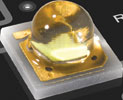

The range of Oslon chip devices offers flexibility and scalability for lighting designs thanks to the different power options (0,5 W, 1 W, 3 W, 5 W) offered in a standard footprint.
Oslon Square – the new addition to the Oslon family – opens up a wide range of possible uses. The LED is suitable for applications where maximum flux over area is needed, for example in designer luminaires for the home or the office, retrofits and street lights. With a footprint of only 3 x 3 mm, it is among the smallest high-power LEDs on the market.
The LED is available in many different versions with various colour temperatures and can be operated with different currents. Its reflective package makes excellent use of the available light and increases system efficiency in all versions. OSRAM’s fine bin system covers the area of two-step MacAdams ellipse, ensuring perfect colour consistency for all lighting applications.
Oslon Square is equipped with OSRAM’s latest power chip technology. This ensures that the LED can be driven up to 1,5 A and remains efficient even at the highest driving currents. It uses the latest phosphor conversion technology to ensure full colour stability over its lifetime – thanks to robust thermal management, lifetimes of more than 50 000 hours can be obtained. Its sturdy design makes the LED resistant to even the harshest conditions.
The white reflective layer of the package guarantees high luminous efficacy. The light reflected back toward the package is reused and directed to the secondary optic, efficiently using every single lumen throughout the entire LED lifetime. A low thermal resistance of only 3,8 K/W ensures cool operation even at high driving currents.
The Oslon Square EC (Eco Champ) is suitable for indoor applications in which a high quality of light is needed, for example in offices. At a colour temperature of 3000 K for example, it provides a warm white light and also offers high colour stability over a wide viewing angle (120°). The CRI is at least 80.
If the lighting needs to be particularly uniform, a ‘fine-bin’ order can be placed for this LED. At an operating current of 700 mA it achieves an efficiency of above 90 lm/W and a luminous flux of 200 lm and more. At 350 mA its efficiency surpasses the 100 lm/W mark. The EC version is also suitable for retrofits. Thanks to its small dimensions it can be closely clustered and, like all the LEDs in this series, it benefits from its reflective package, both individually and within a system.
The Oslon Square PC (Power Champ) and UW (street white) are designed for outdoor applications, for example in street lighting. They can be operated at currents between 200 mA and 1,5 A, making them interesting for other applications such as downlights and spotlights.
The LEDs produce a neutral white to cold white light with colour temperatures of 4000 K to 6000 K. At greater than 130 lm/W from 350 mA in hot conditions they are even more efficient than the warm white version. With a CRI of at least 70 (4000 K) and 65 (6000 K) these LEDs combine good quality of light with high efficiency.

Oslon SSL LED – new generation
Another addition to the Oslon family is the new generation of Oslon SSL LEDs. Like Oslon Square, it is characterised by its small component size of only 3 x 3 mm, two different lenses and the reflectivity of the package. The LED provides a luminous flux of typically 98 lm in warm white (3000 K), with an operating current of 350 mA at an application temperature of 85°C in the chip.
With its typical luminous efficacy of 96 lm/W, referring to the ratio between luminous flux and expended electrical output, it is among the most efficient 1 mm² chip LEDs presently to be found on the market. The combination of higher luminous flux and reduced forward voltage of typically less than 3,0 V equals an efficiency increase of approximately 25%, when compared with the previous generation. For manufacturers of lighting solutions, this makes luminaire development much easier: a smaller number of LEDs attains the same luminous flux, as well as the same efficiency as before.
The latest developments in chip technology, converters and package are the secret to the performance optimisation of the Oslon SSL. The higher temperature stability of its luminous flux, even when operating under ‘hot’ application conditions, significantly simplifies thermal management.
The new Oslon SSL LEDs are available in warm white (3000 K), suitable for interior lighting (type EC), for instance in downlights, as well as in cold white (5000 K), for use in exterior lighting (type PC).
Efficiency by design
The Oslon SSL family was primarily developed for general illumination applications in which maximum light intensity is demanded and the most stringent requirements regarding lifetime are imposed.
With their performance and design they are also suitable for other areas of lighting and illumination technology. Due to their very compact design, the LEDs are particularly suited for combining and operating in clusters.
The design of the Oslon SSL group is based on a joint package concept comprising a ceramic base with integrated contacts (bottom only-terminated) and a hard silicon cast as a lens. The ceramic base has the decisive advantage that it has stable degradation characteristics in regard to light, regardless of the wavelength. In addition, it has sufficiently good thermal conductivity and enables thermal connection to the printed circuit board to be designed electrically neutral.
Highly efficient semiconductor chips with the latest thin-film technology from OSRAM Opto Semiconductors are used as light sources in the Oslon SSL LEDs. The chip technology (ThinGaN/UX:3) uses the semiconductor material composition indium gallium nitride for the colours deep blue, true green and white, and the material composition aluminium indium gallium phosphides (ThinFilm) for the colours amber, yellow and red.
For more information contact Ryan Hunt, OSRAM Opto Semiconductors,+27 (0)79 525 1779, [email protected], www.osram.co.za

© Technews Publishing (Pty) Ltd | All Rights Reserved